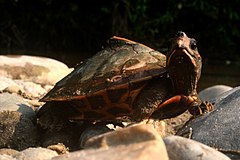Assam roofed turtle
| Assam roofed turtle | |
|---|---|
 |
|
| Scientific classification | |
| Kingdom: | Animalia |
| Phylum: | Chordata |
| Class: | Reptilia |
| Order: | Testudines |
| Suborder: | Cryptodira |
| Family: | Geoemydidae |
| Genus: | Pangshura |
| Species: | P. sylhetensis |
| Binomial name | |
|
Pangshura sylhetensis |
|
| Synonyms | |
|
|
The Assam roofed turtle (Pangshura sylhetensis), also known as Sylhet roofed turtle, is a species of the turtle family Geoemydidae found in the Brahmaputra-Meghna drainage in India (Assam) and parts of eastern Bangladesh. It was formerly placed in the genus Batagur and defunct genus Kachuga.
The species has a triangular and elevated carapace with a prominent spiked keel and strongly serrated marginal plates. The carapace is olive-brown in color, with a lighter (yellowish to beige) keel. The head is small and has a weakly hooked upper jaw; a narrow pink stripe runs from the back of each eye to the middle of the back of the head. Adults may attain a maximum length of 20.5 cm, although body sizes of 16 cm are more common.
The species' local names include দূৰা কাছ in Assamese, and সিলেটী কাইট্টা, সিলেটী কড়ি কাইট্টা, সিলোটী কাইট্টা, সিলেটী কাছিম, and কাঁটা কাছিম। in Bengali.
The species occurs in the north-eastern & south-eastern parts of Bangladesh, in India (Assam) and possibly in Bhutan. It is found in terrestrial and freshwater habitats in areas with upland tropical moist forest, and fast-flowing streams and perhaps also small rivers. Oxbow lakes may also be inhabited, but shell morphology suggests an adaptation to fast-flowing waters.
The species is amphibian. In the cooler months of the dry season, from December to February, it basks during most of the day; individuals living in cooler hill-streams may do so year round. The turtle is shy and never basks on river banks, but only on emergent logs or rocks. At the slightest disturbance, it will dive quickly to the middle of the river, hiding between rocks. Juveniles often flee into accumulations of dead leaves for camouflage and remain motionless.
Assam roofed turtles nest between late October and February, corresponding with the cool, dry season, and produce clutches of 6–12 eggs. Hatchlings appear mainly between March and April, at the beginning of the Southeast Monsoons.
...
Wikipedia

